What was Apartheid?
Table of Contents
Apartheid was a system to keep white people and “non-whites” apart in South Africa. It lasted from about 1950 to the early 1990s. The word Apartheid means “separation” in Afrikaans, a language spoken in South Africa.
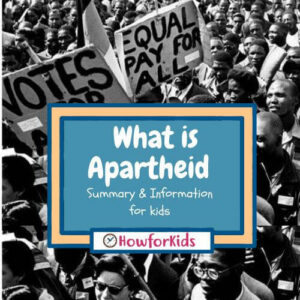
Apartheid System in South Africa
The population of this country is mostly non-white. But for many years the white people of South Africa controlled the government of the country. They established laws that kept the races separate and discriminated against “non-whites” as the majority.
Apartheid Summary. Information for children
Apartheid divided South Africans into four groups: Whites, Bantu (blacks), Coloreds (of mixed descent), and Asians.
The policy created separate areas in the cities for each group. Members of a group were not allowed to live, do business, or own land outside their area. Under the “Pass” laws, “non-whites” had to carry passes while in white areas.
Other laws established separate schools and restricted each race to different types of work. The government also created 10 territories called “patrias” and forced blacks to move to these places.
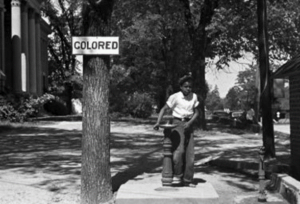
Timeline of Apartheid
With the support of some whites, many blacks in South Africa protested against apartheid. The African National Congress (ANC) led the fight. The protests sometimes turned violent. A district called Soweto fought in 1976 against a requirement that blacks learn Afrikaans. In 1985 Great Britain and the United States restricted trade with South Africa.
In response to the protests, the South African government gave non-whites some rights in the late 1980s. Between 1990 and 1991 the government led by President F.W. de Klerk ended most of the Apartheid laws. In 1994 all races were allowed to vote in national elections. Nelson Mandela, leader of the ANC, was elected president. Apartheid ended, but its effects remain. Racial discrimination continued in South Africa.
Living under Apartheid
Living under apartheid was not fair to people of color. They were forced to live in certain areas and were not allowed to vote or travel in “white” areas without papers. Colored people and white people could not marry each other. Many blacks, Asians, and other people of color were forced out of their homes and into regulated areas called “homelands.”
The government also took over the schools and forced the segregation of black and white students. Signs were posted in many areas declaring those areas “white people only.” People of color who broke the laws were punished or jailed.
In the 1950s many groups formed to protest apartheid. The protests were called the Resistance Campaign. The most prominent of these groups was the African National Congress. Initially the ANC protests were non-violent. However, after 69 protesters were killed by police in the Sharpeville massacre in 1960, they began to take a more military approach.
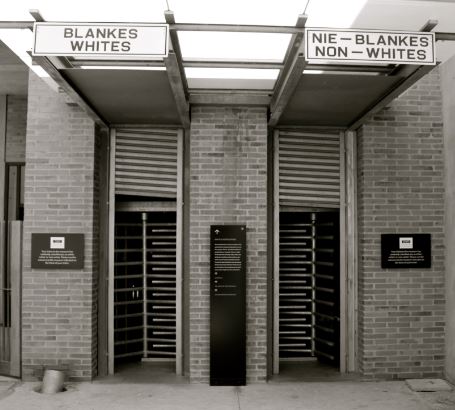
The Population Registration Act of 1950
The Population Registration Act of 1950 caused people to be placed into four groups based on the color of their skin, and registered with the government when they were born. These groups were:
•White
• Bantu (Black African)
• Colored race (a person who was not white or Bantu)
• Other (a person who did not fit into the other three categories)
But knowing someone’s color wasn’t always easy. Tests such as how someone spoke or what physical characteristics someone had were used to decide which group they should be placed in. Because this law did not give specific definitions of each group, people from the same family were sometimes placed in different groups.
The Group Areas Act of 1950
The Group Areas Act of 1950 set aside places in South Africa called “group areas” where people must live with others in their same race group. Whites could only live with whites, Bantus with other Bantus, and so on.
But this also meant that people who lived in the wrong group area had to move, even if they knew nothing of where they were forced to go. Many had to leave the houses where they had lived for most of their lives. It was like someone forced you out of your home to go live in a different town that you had never seen just because you weren’t the right color.
This act also moved black people out of the cities to try to keep them poor and less educated than whites so they couldn’t rise up against the government.
The Separate Services Act
The Separate Services Act prevented white people from mixing with other races in public. Whites had their own public buildings, doctors’ offices, and public transportation that other racial groups could not use. But the separation of services also meant that white people had things like their own beaches, restrooms, and benches, too.
Apartheid: Nelson Mandela
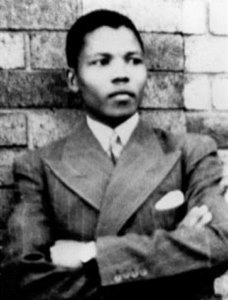
One of the ANC leaders was a lawyer named Nelson Mandela. After the Sharpeville massacre, Nelson led a group called the Umkhonto we Sizwe. This group took military action against the government including bombing buildings. Nelson was arrested in 1962 and sent to prison. He spent the next 27 years in prison. During this time in prison he became the symbol of the people against apartheid.
Soweto Uprising
On June 16, 1976, thousands of high school students took to the streets in protest. The protests began peacefully, but as protesters and police clashed, they turned violent. The police shot at the children. At least 176 people were killed and thousands more were injured. One of the first to be killed was a 13-year-old boy named Hector Pieterson. Hector has become an important symbol for the uprising. Today, June 16 is remembered on a public holiday called Youth Day.
International pressure
In the 1980s, governments around the world began to pressure the South African government to end apartheid. Many countries stopped trading with South Africa by imposing economic sanctions against them. As pressure and protests increased, the government began to relax some of the apartheid laws.
The End of Apartheid
Apartheid finally ended in the early 1990s. Nelson Mandela was released from prison in 1990 and a year later South African President Frederik Willem de Klerk scrapped the remaining apartheid laws and called for a new constitution. In 1994, a new election was held in which people of color could vote. The ANC won the election and Nelson Mandela became the president of South Africa.
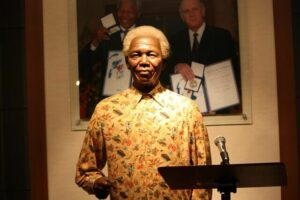
Basic Facts about Apartheid
1. Apartheid means separation in the Afrikaans language.
2. Apartheid was the political and social norm of racial segregation and discrimination enforced by white minority governments in South Africa from 1948 to 1994.
3. “The white people of South Africa ruled everything. Under the laws that became known to the world as apartheid, black people were not allowed to live near white people. They couldn’t marry white people. They couldn’t share white bathrooms, restaurants, sports spaces and bars. They had to carry passes. They were treated like animals.”
4. People were segregated into different groups: Whites, Blacks, Indians, and people of color.
5. Apartheid touched every aspect of social life, including a ban on marriage among non-whites, and the sanctioning of “whites only” jobs.
Read Also: History of Computer
